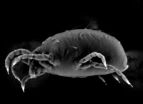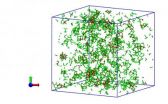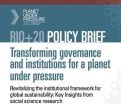(Press-News.org) WORCESTER, Mass. – Each fall millions of monarch butterflies from across the eastern United States use a time-compensated sun compass to direct their navigation south, traveling up to 2,000 miles to an overwintering site in a specific grove of fir trees in central Mexico. Scientists have long been fascinated by the biological mechanisms that allow successive generations of these delicate creatures to transverse such long distances to a small region roughly 300 square miles in size. To unlock the genetic and regulatory elements important for this remarkable journey, neurobiologists at the University of Massachusetts Medical School (UMMS) are the first to sequence and analyze the monarch butterfly genome.
"Migratory monarchs are at least two generations removed from those that made the journey the previous fall," said Steven M. Reppert, MD, professor and chair of neurobiology and senior author of the study. "They have never been to the overwintering sites before, and have no relatives to follow on their way. There must be a genetic program underlying the butterflies' migratory behavior. We want to know what that program is, and how it works."
In a paper published in the journal Cell, Reppert and UMMS colleagues Shuai Zhan, PhD, and Christine Merlin, PhD, along with collaborator Jeffrey L. Boore, PhD, CEO of Genome Project Solutions, describe how next-generation sequencing technology was used to generate a draft 273 Mb genome of the migratory monarch. Analysis of the combined genetic assembly revealed an estimated set of 16,866 protein-coding genes, comprising several gene families likely involved in major aspects of the monarch's seasonal migration. The novel insights observed by Reppert and colleagues in the newly sequenced monarch genome include:
identifying genes involved in visual input and central processing by the sun compass
a full repertoire of molecular components for the monarch circadian clock
all members of the juvenile hormone biosynthetic pathway whose regulation is critical for a successful migration and which shows an unexpected regulation pattern
additional molecular signatures of oriented flight behavior
monarch-specific expansions of odorant receptors potentially important for long-distance migration
a variant of the sodium/potassium pump that underlies a valuable chemical defense mechanism to fend off predators during the migration
"Why sequence another species?" said Laurie Tompkins, Ph.D., who oversees grants focused on the genetics of behavior at the National Institutes of Health's National Institute of General Medical Sciences, which supported the work. "In this case, it's because monarch butterflies are exceptional in that they migrate thousands of miles, seasonally. Genomic sequence provides the raw material for understanding the remarkable behavioral and physiological adaptations that enable the butterflies' long-distance migration."
Understanding the relationship between genes, behavior and physiological adaptations in monarchs may also lead to new insights into similar connections in humans. Circadian clocks, for instance, are a crucial component in the complex time-compensated sun compass system governing a monarch's ability to navigate long distances and are now understood to play a pivotal role in human biology. Temporal variations in hormone levels, pharmacokinetics, and disease processes, such as the increased incidence of heart attacks in the early morning, reveal the prominent influence of the circadian clock on human physiology. Understanding the molecular mechanisms of the circadian clock has already helped reveal how clock gene mutations contribute to disorders of the timing of sleep, and new insights into these genetic processes could illuminate how clock gene mutations contribute to diseases like major depression and seasonal affective disorder.
"In terms of fundamental brain processes, those involved in the navigation mechanisms used for long-distance migration have been difficult to decipher," said Reppert. "Dissecting the genetic basis of long-distance migration in the monarch may help us understand these mechanisms not only in monarchs but more generally in other migrants, including migratory birds and sea turtles."
###This project was supported by American Recovery and Reinvestment Act (ARRA) funds from the National Institute of General Medical Sciences, National Institutes of Health. This research project was initiated with aid from the Higgins Family.
About the University of Massachusetts Medical School
The University of Massachusetts Medical School, one of the fastest growing academic health centers in the country, has built a reputation as a world-class research institution, consistently producing noteworthy advances in clinical and basic research. The Medical School attracts more than $307 million in research funding annually, 80 percent of which comes from federal funding sources. The mission of the Medical School is to advance the health and well-being of the people of the commonwealth and the world through pioneering education, research, public service and health care delivery with its clinical partner, UMass Memorial Health Care. For more information, visit http://www.umassmed.edu.
UMMS scientists present draft sequence of monarch butterfly genome
Butterfly genome yields new insights into genetic basis of seasonal migration
2011-11-24
ELSE PRESS RELEASES FROM THIS DATE:
Researchers discover clues to developing more effective antipsychotic drugs
2011-11-24
Researchers from Mount Sinai School of Medicine, have identified the pattern of cell signaling induced by antipsychotic drugs in a complex composed of two brain receptors linked to schizophrenia. The discovery should allow researchers to predict the effectiveness of novel compounds for the treatment of schizophrenia and other serious mental disorders and may accelerate the development of better antipsychotic drugs. The findings are published in the November 23 issue of Cell.
Until now, the molecular mechanism through which current treatments for schizophrenia achieve ...
Big pest, small genome
2011-11-24
SALT LAKE CITY, Nov. 23, 2011 – A University of Utah biologist and an international research team decoded the genetic blueprint of the two-spotted spider mite, raising hope for new ways to attack the major pest, which resists pesticides and destroys crops and ornamental plants worldwide.
The voracious mites, which technically are not insects, can eat more than 1,100 plant species – a rare trait. The mites' newly revealed and sequenced genome contains a variety of genes capable of detoxifying pesticides as well as toxins plants use to defend themselves, the scientists ...
Hours of Service Rules for Commercial Truck Drivers Traveling Through Atlanta
2011-11-24
Almost a year ago, the Federal Motor Carrier Safety Administration (FMCSA) proposed new limits on Hours of Service (HOS) rules for commercial drivers. While the intent was to improve highway safety for all who travel by limiting fatigue among truck drivers, the proposed changes have come under fire from trucking advocacy groups as having little impact on highway safety. The proposed changes in hours of service have not yet been finalized.
Existing Hours of Service Limitations for Commercial Drivers
HOS regulations generally apply to all drivers of commercial vehicles. ...
Supercool
2011-11-24
SALT LAKE CITY -- We drink water, bathe in it and we are made mostly of water, yet the common substance poses major mysteries. Now, University of Utah chemists may have solved one enigma by showing how cold water can get before it absolutely must freeze: 55 degrees below zero Fahrenheit.
That's 87 degrees Fahrenheit colder than what most people consider the freezing point of water, namely, 32 F.
Supercooled liquid water must become ice at minus 55 F not just because of the extreme cold, but because the molecular structure of water changes physically to form tetrahedron ...
Dana-Farber/Children's Hospital Boston study identifies possible therapy for radiation sickness
2011-11-24
BOSTON—A combination of two drugs may alleviate radiation sickness in people who have been exposed to high levels of radiation, even when the therapy is given a day after the exposure occurred, according to a study led by scientists from Dana-Farber Cancer Institute and Children's Hospital Boston.
Mouse studies of other potential therapies suggest they would be effective in humans only if administered within a few minutes or hours of radiation exposure, making them impractical for use in response to events involving mass casualties. In contrast, the larger time window ...
UN overhaul required to govern planet's life support system: Experts
2011-11-24
Reducing the risk of potential global environmental disaster requires a "constitutional moment" comparable in scale and importance to the reform of international governance that followed World War II, say experts preparing the largest scientific conference leading up to next June's Rio+20 Earth Summit.
Stark increases in natural disasters, food and water security problems and biodiversity loss are just part of the evidence that humanity may be crossing planetary boundaries and approaching dangerous tipping points. An effective environmental governance system needs to ...
Disability Insurance Claim Denied? An ERISA Lawsuit Could Help
2011-11-24
Private disability insurance can be a significant source of value for employees and their families, and they expect to be able to rely on it in their times of need. But what happens when an employee's disability insurance claim is denied?
A comprehensive federal law known as the Employee Retirement Income Security Act of 1974, or ERISA, protects the interests of participants in many types of insurance plans. ERISA sets standards for the administration of benefit plans, including the proper procedure for appealing a denial of a claim for benefits. If the claims process ...
Earth's core deprived of oxygen
2011-11-24
Washington, D.C. — The composition of the Earth's core remains a mystery. Scientists know that the liquid outer core consists mainly of iron, but it is believed that small amounts of some other elements are present as well. Oxygen is the most abundant element in the planet, so it is not unreasonable to expect oxygen might be one of the dominant "light elements" in the core. However, new research from a team including Carnegie's Yingwei Fei shows that oxygen does not have a major presence in the outer core. This has major implications for our understanding of the period ...
New butterfly species identified in Yucatan peninsula
2011-11-24
About 160,000 species of butterflies and moths are already known, but scientists believe that a similar number still remain undiscovered. Identification and characterization of these species can be complicated by the fact that each species has an immature caterpillar and a mature butterfly form, as well as the reliance on the physical appearance for classification.
Now, though, researchers report that a type of DNA analysis called "barcoding" may provide a powerful tool in this effort, according to a study published in the Nov. 16 issue of the online journal PLoS ONE. ...
Public restrooms ripe with bacteria, study says
2011-11-24
Everyone wonders what bugs might be lurking in public bathrooms. Now researchers are using novel genetic sequencing methods to answer this question, revealing a plethora of bacteria all around, from the doors and the floors to the faucet handles and toilet seats, with potential public health implications, as reported Nov. 23 in the online journal PLoS ONE.
Led by Gilberto Flores and Noah Fierer of the University of Colorado, Boulder, the researchers investigated 12 public restrooms, 6 male and 6 female, in Colorado. Using a high-throughput genetic sequencing technique, ...
LAST 30 PRESS RELEASES:
School meals could unlock major gains for human and planetary health
Menopause hormone therapy does not appear to impact dementia risk
Signature patterns of brain activity may help predict recovery from traumatic brain injury
Dresden study uncovers new key mechanism in cancer cells
New species are now being discovered faster than ever before, study suggests
Cannabis-based products show limited short-term benefit for chronic pain, with increased risk of adverse effects
Cannabis products with more THC slightly reduce pain but cause more side effects
Clearing the brain of aging cells could aid epilepsy and reduce seizures
Brain injuries linked with potential risk of suicide, new study finds
New technique lights up where drugs go in the body, cell by cell
New study finds movement of fishing fleets can reveal shifts in marine ecosystems
Embargoed: New evidence points to potential treatment for vascular dementia
Study uncovers disrupted brain balance in alcohol dependence
Working in groups can help Republicans and Democrats agree on controversial content moderation online
Structural findings reveal how distinct GPCR ligands create different levels of activation
Anything-goes “anyons” may be at the root of surprising quantum experiments
UC review: Maximizing workplace opportunity for veterans
From generation to complex control: Metasurfaces make perfect vortex beams "within reach"
Thin-film lithium niobate-based detector: recent advances and perspectives
Exploring why some people may tend to persistently make bad choices
How cells balance their protein levels
Nirsevimab vs RSVpreF vaccine for RSV–related hospitalization in newborns
Effectiveness and impact of maternal RSV immunization and nirsevimab on medically attended RSV in US children
AI gives scientists a boost, but at the cost of too many mediocre papers
Next-generation vision model maps tree growth at sub-meter precision
Genes aren’t destiny for inherited blindness, study shows
MIT study: High-fat diets make liver cells more likely to become cancerous
Exposure to multiple fine particulate matter components and incident depression in the US Medicare population
Risk of burdensome health care spending over time in the US
Nirsevimab against hospitalizations and emergency department visits for lower respiratory tract infection in infants
[Press-News.org] UMMS scientists present draft sequence of monarch butterfly genomeButterfly genome yields new insights into genetic basis of seasonal migration


